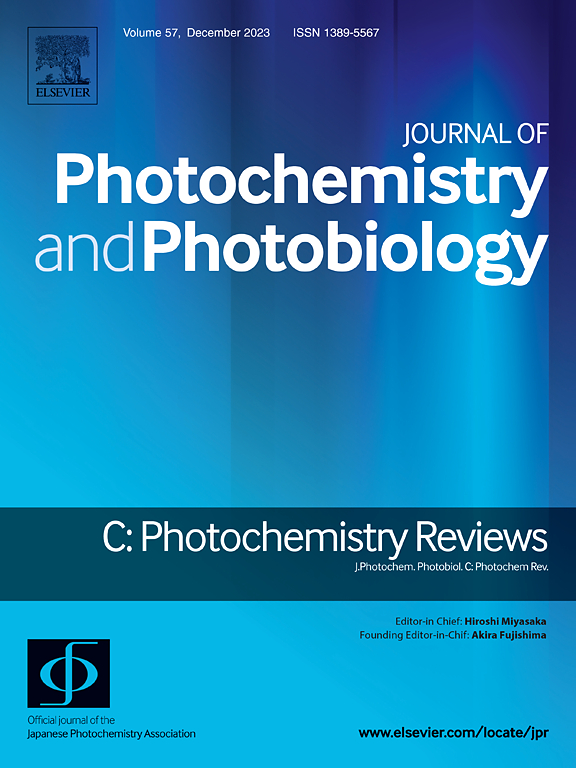Boron doped nanomaterials for photocatalysis
IF 13.1
1区 化学
Q1 CHEMISTRY, PHYSICAL
Journal of Photochemistry and Photobiology C: Photochemistry Reviews
Pub Date : 2024-11-10
DOI:10.1016/j.jphotochemrev.2024.100679
引用次数: 0
Abstract
Photocatalysis, by harnessing solar light to drive essential chemical transformations, is recognized for its transformative potential in sustainable energy production and environmental remediation, addressing critical global challenges such as CO2 reduction, water splitting, ammonia synthesis, etc. The development of novel photocatalytic composite materials is crucial, not only enhancing reaction efficiencies but also enabling more effective utilization of solar energy, thus propelling the field towards practical and scalable solutions. Among these materials, composites such as boron (B)-doped titanium dioxide, B-doped graphene, and B-doped carbon nitride are distinguished by their exceptional performance in various photocatalytic reactions. These enhancements are primarily attributed to the unique electronic structure of B, its small size and electron deficiency facilitate improved carrier detached and diminished regrouping rates, thereby expanding the spectrum of light absorption. Despite considerable advancements, the specific role of B within photocatalytic systems remains ambiguously defined, with ongoing research yet to conclusively determine whether B functions primarily as a catalyst (a key) or merely as a supportive enhancer (an auxiliary). Addressing this gap, this review adopts a novel analytical perspective, investigating the electron-deficient nature of B to elucidate it’s in photocatalysis distinct advantages, potential regimes, and practical applications. The review further delineates the current dilemmas and articulates future directions within the photocatalysis. By aiming to systematically characterize B's role in photocatalytic processes, this comprehensive review offers essential scientific and practical insights, pivotal for the development of more efficacious, innovative photocatalysts. Enhancing our understanding of the underlying mechanisms in photocatalytic reactions, this work substantially contributes to the achievement of sustainable development goals and establishes a foundation in this critical area for future.
用于光催化的掺硼纳米材料
光催化利用太阳光驱动基本的化学转化,在可持续能源生产和环境修复方面具有巨大的变革潜力,可解决二氧化碳减排、水分离、氨合成等重大全球性挑战。新型光催化复合材料的开发至关重要,不仅能提高反应效率,还能更有效地利用太阳能,从而推动该领域向实用和可扩展的解决方案发展。在这些材料中,掺硼二氧化钛、掺硼石墨烯和掺硼氮化碳等复合材料因其在各种光催化反应中的优异性能而独树一帜。这些性能的提高主要归功于掺硼元素独特的电子结构,掺硼元素的小尺寸和电子缺陷有助于提高载流子脱离率和降低重组率,从而扩大光吸收光谱。尽管取得了长足的进步,但 B 在光催化系统中的具体作用仍不明确,目前的研究尚未最终确定 B 的功能是主要作为催化剂(关键)还是仅仅作为支持性增强剂(辅助)。针对这一空白,本综述采用了新颖的分析视角,通过研究 B 的缺电子特性来阐明它在光催化中的独特优势、潜在机制和实际应用。这篇综述进一步划分了光催化目前的困境,并阐明了未来的发展方向。通过系统地描述 B 在光催化过程中的作用,这篇全面的综述提供了重要的科学和实践见解,对于开发更有效、更创新的光催化剂至关重要。这项研究加深了我们对光催化反应内在机理的理解,为实现可持续发展目标做出了重大贡献,并为这一关键领域的未来发展奠定了基础。
本文章由计算机程序翻译,如有差异,请以英文原文为准。
求助全文
约1分钟内获得全文
求助全文
来源期刊
CiteScore
21.90
自引率
0.70%
发文量
36
审稿时长
47 days
期刊介绍:
The Journal of Photochemistry and Photobiology C: Photochemistry Reviews, published by Elsevier, is the official journal of the Japanese Photochemistry Association. It serves as a platform for scientists across various fields of photochemistry to communicate and collaborate, aiming to foster new interdisciplinary research areas. The journal covers a wide scope, including fundamental molecular photochemistry, organic and inorganic photochemistry, photoelectrochemistry, photocatalysis, solar energy conversion, photobiology, and more. It provides a forum for discussing advancements and promoting collaboration in the field of photochemistry.

 求助内容:
求助内容: 应助结果提醒方式:
应助结果提醒方式:


